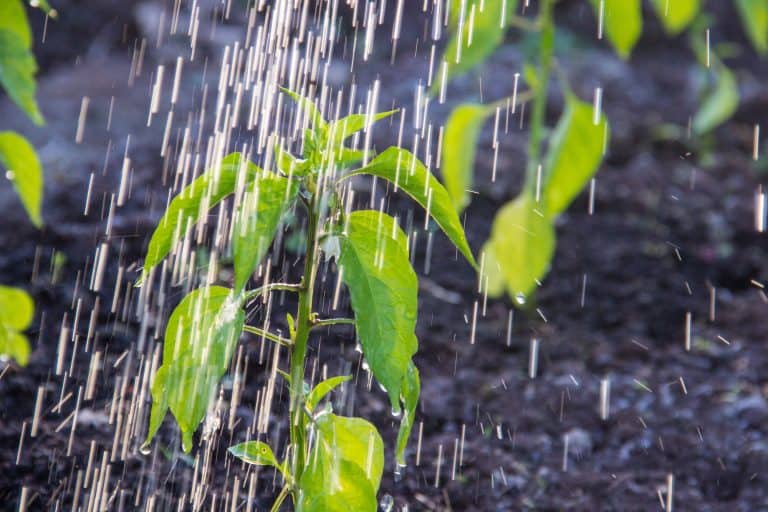How long do peppers take to grow?
When it comes to growing peppers, the question of how long they take to reach maturity is often met with the familiar response: “It depends.”
Indeed, the timeline for pepper growth can vary based on several factors, including the starting point for counting, the specific pepper variety, and the unique conditions in which they are grown.
Read on to explore the various factors that influence the time it takes for peppers to grow, from germination to fruiting. By understanding these variables, you’ll be better equipped to plan and anticipate the growth timeline for your peppers, ensuring a successful and rewarding harvest.
What does “days to harvest” mean? From seed or from transplant?
When determining the timeline for growing peppers, it’s essential to understand the meaning behind the term “days to harvest.” Seed providers often mention this metric to indicate the duration from a particular stage of the pepper plant’s growth. However, it can sometimes be unclear whether they refer to the day you sow the seed or transplant the seedling into its final growing spot.
In cases where the information is not explicitly specified, it is generally safe to assume that “days to harvest” refers to the duration starting from the day of transplant. This means the count begins from the moment you transfer your young pepper plant from its initial container to its permanent location, such as a garden bed or a larger pot.
Considering this distinction is crucial, as the timeline for peppers can vary significantly depending on whether you are calculating from seed sowing or transplanting.
How long does it take peppers to germinate?
Germination, the process of pepper seeds sprouting and establishing root growth, can vary in duration depending on various factors such as the pepper variety, seed quality, and seed age. Typically, most pepper seeds will germinate within 7 to 10 days. I have had pepper seeds germinate in as little as 4 days, although it’s not particularly common.
If your pepper seeds are struggling to germinate, it’s important to assess the conditions they are exposed to. In some cases, providing additional heat may be necessary. Consider using a heat mat or adjusting the room temperature to create a more favorable environment for germination.
It’s worth noting that certain super hot pepper varieties are notorious for their slow germination process. For instance, peppers like the T-rex pepper (1.5+ million SHU) and Primotalii Red (1+ million SHU) require higher temperatures of around 80-85°F (27-29°C) for successful germination. Even under ideal conditions, these super-hot peppers can take up to 6 weeks to germinate.
Patience and maintaining optimal conditions when waiting for your pepper seeds to germinate are important. By providing the appropriate temperature and caring for your seeds, you increase the chances of successful germination and the subsequent growth of healthy pepper seedlings.
How long do peppers take from transplant?
The duration from transplanting pepper seedlings to the actual harvest can vary depending on the specific type of pepper and the conditions in which they are grown. In general, when seed providers mention “days to harvest,” they typically mean the number of days from the moment of transplant to when the peppers are ready for harvest.
It’s important to note that the time to harvest can be influenced by various factors, including the specific pepper variety and the growing conditions you provide. Factors such as soil quality, sunlight exposure, temperature, and other environmental variables can impact the growth rate of peppers.
Personally, I am working with heavy clay soil and excessive shade, so my peppers will take longer than average to grow. I expect them to take 10-20 days to fully mature.
While it’s important to be aware of the potential impact of less-than-ideal conditions, it’s worth noting that peppers are generally resilient plants and can still thrive and produce a bountiful harvest even in less-than-perfect circumstances. By providing the best care and making any necessary adjustments to address the specific challenges you encounter, you can maximize the growth and yield of your pepper plants.
How long do peppers take to grow after flowering?
After a pepper plant flowers and the flowers are successfully pollinated, the time it takes for the peppers to fully mature can vary widely. On average, it can range from approximately 14 days to 2 or 3 months. However, specific pepper varieties and growing conditions play a significant role in determining the exact duration.
Most Capsicum annuum peppers, which include popular varieties like bell peppers and jalapeños, typically take around 35 to 50 days from flowering to full maturity.
Cayenne peppers should be picked around 40 days into the maturing process for maximal spiciness (Barbero et al., 2014). Habaneros, chiles de arbol, and piquin peppers should reach full maturity within a slightly longer timeframe of 40 to 55 days (Contreras-Padilla & Yahia, 1998).
It’s important to note that these timeframes are general guidelines and can still be influenced by factors such as temperature, sunlight exposure, soil conditions, and individual plant health. Monitoring the progress of your peppers and observing their color, size, and other visual indicators will help you determine the optimal time for harvesting and enjoying the flavorful bounty of your pepper plants.
So how long do they take to grow from seed to fruit?
The duration for peppers to grow from seed to mature, ripe fruit can vary depending on the specific pepper variety and the information provided on the seed packet. If the “days to harvest” date mentioned on the seed packet refers to the period after transplanting, some calculation is required to determine the overall timeline.
Generally, most pepper seeds should be started indoors approximately 8 to 10 weeks before the intended transplant date. By adding this timeframe to the “days to harvest” date provided, you can estimate the total number of days required for peppers to grow from seed to fruit.
For instance, consider a hypothetical scenario where the seed packet indicates a “days to harvest” of 65 days from transplant. If we add the typical 8 to 10 weeks (56 to 70 days) of seed starting time, we estimate that the pepper will require approximately 125 days from seed to reach maturity. To put it into perspective, if you start the seeds indoors in early March, you can expect to have ripe peppers in early to mid-July.
It’s important to note that the overall time for peppers to grow from seed to fruit can vary significantly, ranging from approximately 100 to 265 days. This broad range takes into account the diverse characteristics of different pepper varieties and their specific growth requirements.
What are some of the fastest-maturing peppers?
When it comes to fast-maturing peppers, several varieties can meet your needs, whether you’re eager for quick results, looking to extend your harvest season, or dealing with a shorter warm season. It’s worth noting that the size of the pepper fruit can influence its maturity time, with smaller peppers generally maturing faster than larger ones, such as bell peppers and poblanos. However, some small peppers may still require longer to reach maturity.
Furthermore, the desired ripeness level for harvest can also affect the timeline. For example, jalapeños can be harvested both when they are green and when they mature to a red color. Green jalapeños are typically ready for picking several days earlier than red ones.
While the list provided below is not exhaustive, it includes some fast-maturing pepper varieties based on heat level. The specific days to maturity data are guidelines from Pepper Joe.
Quick to mature mild peppers:
Quick to mature medium peppers:
| Pepper Variety | Days to Maturity |
|---|---|
| Bulgarian carrot | 70+ |
| NuMex twilight | 70+ |
| Serranos | 75+ |
| Buena mulata | 75-80 |
Quick to mature hot peppers:
| Pepper Variety | Days to Maturity |
|---|---|
| Chocolate Fatalii | 70+ |
| Peach habanero | 75+ |
| Big sun habaneros | 80+ |
| Burning bush | 85+ |
| Lemon habanero | 90+ |
Quick to mature super-hot peppers:
| Pepper Variety | Days to Maturity |
|---|---|
| Bane Strain peach | 90+ |
| Pepper “B” mustard | 90+ |
| Carolina reaper | 90 – 150 |
| Apocalypse scorpion | 90-120 |
| Naga viper | 100+ |
Maturity times for some of the most popular peppers:
| Pepper Variety | Days to Maturity |
|---|---|
| Bell pepper | 75+ |
| Jalapeño | 65+ |
| Serrano | 75+ |
| Cayenne | 80+ |
| Habanero | 90 – 100 |
| Scotch bonnet | 100+ |
| Carolina reaper | 90-150 |
| Ghost pepper | 150+ |
| Moruga Trinidad scorpion | 150+ |
Please note that the maturity times provided are approximate and can vary based on growing conditions and specific pepper varieties. They indicate time to maturity from transplant.
What are the slowest-maturing peppers?
The slowest-maturing peppers, particularly super-hot varieties, generally require longer to reach maturity than other peppers. These peppers have extended maturation periods and take longer to germinate. Here are some examples of slow-maturing peppers:
- Black pearl: This variety of pepper can take up to 120 days to reach maturity from transplant.
- Carolina reaper: Known for its extreme spiciness, Carolina Reapers can take up to 150 days to mature.
- Ghost pepper: Also referred to as Bhut Jolokia, Ghost Peppers can take approximately 150+ days to reach maturity.
- Brazilian Moruga: These seeds require a significantly longer maturation time of 165+ days.
- Jay’s peach ghost scorpion pepper: This pepper variety can take up to 175+ days to mature.
As you embark on your pepper-growing journey, it’s important to remember that patience is a virtue in the world of gardening. While we have discussed general timelines and average maturation periods for different pepper varieties, it’s crucial to understand that each plant is unique and may require more time or extra care to thrive.
So, whether you’re eagerly waiting for those first sprouts to emerge or anxiously anticipating the ripening of your peppers, remember that nature works on its own schedule.
References
Barbero, G. F., Ruiz, A. G., Liazid, A., Palma, M., Vera, J. C., & Barroso, C. G. (2014). Evolution of total and individual capsaicinoids in peppers during ripening of the Cayenne pepper plant (capsicum annuum L.). Food Chemistry, 153, 200–206. https://doi.org/10.1016/j.foodchem.2013.12.068
Contreras-Padilla, M., & Yahia, E. M. (1998). Changes in capsaicinoids during development, maturation, and senescence of Chile Peppers and relation with peroxidase activity. Journal of Agricultural and Food Chemistry, 46(6), 2075–2079. https://doi.org/10.1021/jf970972z






